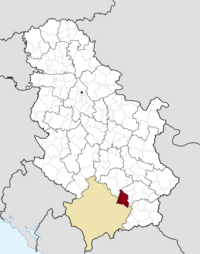Medveđa
|
Medveđa Медвеђа |
||
|---|---|---|
| Town and municipality | ||
|
||
 Location of the municipality of Medveđa within Serbia |
||
| Coordinates: 42°50′N 21°35′E / 42.833°N 21.583°ECoordinates: 42°50′N 21°35′E / 42.833°N 21.583°E | ||
| Country |
|
|
| Region | Southern and Eastern Serbia | |
| District | Jablanica | |
| Settlements | 44 | |
| Government | ||
| • Mayor | Dragiša Petrović | |
| Area | ||
| • Municipality | 524 km2 (202 sq mi) | |
| Population (2011 census) | ||
| • Town | 3,236 | |
| • Municipality | 7,438 | |
| Time zone | CET (UTC+1) | |
| • Summer (DST) | CEST (UTC+2) | |
| Postal code | 16240 | |
| Area code | +381 16 | |
| Car plates | LE | |
| Website | www |
|
Medveđa (Serbian Cyrillic: Медвеђа, pronounced [ˈmɛdvɛdʑa], Albanian: Medvegja) is a town and municipality located in the Jablanica District of the southern Serbia. According to the 2011 census, the municipality of Medveđa has a population of 7,438 people, while the town has a population of 2,848.
The name is derived from the Serbian word medved (медвед), "bear", hence meaning "the place of the bears".
During the Roman period, there was a town (mansia) with the name Idimum located in the cadastral area of the modern town. Architectural debris dating to the 4th century AD lay at various locations of the town, as it was a transitory zone of Upper Moesia; travel and postal stations are among the finds.
Toponyms such as Arbanaška and Đjake shows an Albanian presence in the Toplica and Southern Morava regions (located north-east of contemporary Kosovo) before the expulsion of Albanians during 1877–1878 period. The rural parts of Jablanica valley and adjoining semi-mountainous interior was inhabited by compact Muslim Albanian population while Serbs in those areas lived near the river mouths and mountain slopes and both peoples inhabited other regions of the South Morava river basin. As the wider Jabllanica region, Medveđa also had an Albanian majority. These Albanians were expelled by Serbian forces in a way that today would be characterized as ethnic cleansing. Due to depopulation and economic considerations some small numbers of Albanians were allowed to stay and return though not to their previous settlements and instead were designated concentrated village clusters in the Toplica, Masurica and Jablanica areas. Of those only in the Jablanica valley centered around the town of Medveđa have small numbers of Albanians and their descendants remained. This was due to a local Ottoman Albanian commander Shahid Pasha from the Jablanica area negotiating on good terms with Prince Milan and thereby guaranteeing their presence.
...
Wikipedia

